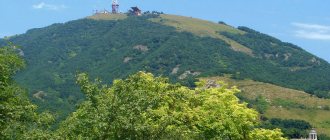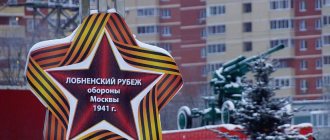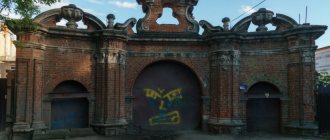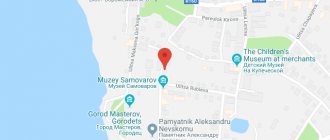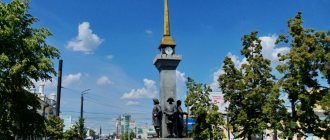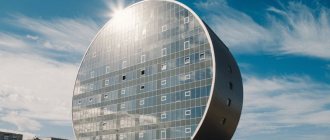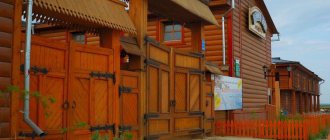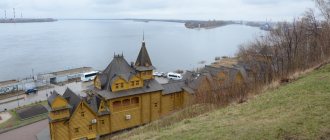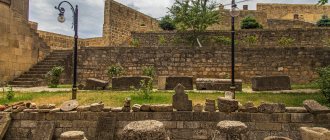To say that you have seen Rostov, it is enough to come here for one day and visit two places: the Kremlin and the Spaso-Yakovlevsky Monastery. The city is small, and you will definitely have time, but I advise you to come for the whole weekend and take a leisurely walk around Rostov, leafing through this guide on your phone.
I tried to put things in order in my head and create a guide to Rostov the Great. I am often on the M8 highway in the Rostov region and when I have time, I go into the city. You can do the same if you are driving along the Moscow-Yaroslavl highway. While passing through, you will take a walk around the Kremlin and then move on.
View from the porch of the Red Chamber. In the background is the Assumption Cathedral
Rostov is a very ancient city. It was first mentioned in the Tale of Bygone Years in the entry of 862 already as an existing city of the Merya tribe. And what’s interesting is that it is mentioned precisely in the entry where our ancestors call on Rurik to reign over Rus'. Remember these words: “Our land is great and abundant, but there is no order in it...”? Still relevant. Two interesting facts:
- Rostov is the birthplace of the epic hero Alyosha Popovich.
- The film “Ivan Vasilyevich Changes His Profession” was filmed in the Rostov Kremlin.
What to see in Rostov
Attractions in Rostov-Veliky are divided into two groups: the Kremlin and all the rest.
Among all the others, the most interesting are the Spaso-Yakovlevsky Monastery and the Museum of Enamel.
Main advice: The Kremlin is a mandatory program, and you already have enough time to add to it.
Rostov Kremlin
Metropolitan's courtyard in winter
The Rostov Kremlin is not difficult to find in the city.
All roads lead to him. From the bypass, you enter the city along any road and drive straight until you hit the Kremlin wall.
Interesting fact: the Kremlin is not actually a Kremlin.
Until the mid-18th century it was not even called by this word.
In fact, this is the residence of the Rostov-Yaroslavl Metropolitan. No matter how powerful this structure may look, its function is purely decorative. It can only protect against petty hooligans.
The windows do not reveal the defensive function of these walls.
You don’t even need to measure their thickness and height. There should be no windows on real Kremlin walls, only loopholes. And Rostov had no strategic significance during the construction of the Kremlin.
The ramparts around the Kremlin are also not for defense. About them below.
The Kremlin was built by Metropolitan Jonah Sysoevich at the end of the 17th century. He wanted to make his residence similar to the description of heavenly Jerusalem. It turned out beautiful.
View of the Rostov Kremlin from above. In the foreground are the roofs of 19th-century shops. Behind them is Gostiny Dvor (on the left) and Cathedral Square of the Kremlin (on the right). Inside Gostiny Dvor there is a Church of the Savior on the market. In the background is Lake Nero / photo by Grigory Yaffa
The Rostov Kremlin consists of three parts:
- Cathedral Square (free admission)
- Metropolitan's Courtyard
- Metropolitan Garden
All these areas are surrounded by a wall.
Cathedral Square
Entry here is free.
There are gates on two sides: the Holy Gate in the western wall and a small gate near the belfry. On the side of the Holy Gate there is a parking lot and shops with souvenirs. You don’t have to worry about parking; there are plenty of places to leave your car around the Kremlin.
Still from the film “Ivan Vasilyevich changes his profession.” The corner of the Assumption Cathedral is visible on the right
On the cathedral square there is a large, white and very ancient Assumption Cathedral, next to it is a belfry. On the belfry one flight is larger than the others; there hangs a huge Sysoy bell. Opposite the cathedral is a powerful wall with two round towers and the domes of the Church of the Resurrection above them. Between the towers there is a narrow passage into the courtyard.
Remember the scene from the film “Ivan Vasilyevich Changes His Profession”, from this square the tsar’s army went to war.
Belfry
At the Rostov belfry. Sysoy is the farthest
The main attraction of the belfry is the huge bell of Sysoy. It weighs 32 tons (2000 pounds). It's like a Kamaz loaded with crushed stone. Casting a product of this size is not easy even today.
The bell was made in 1688, during the early years of the reign of Peter I and his older brother Ivan V.
The bell hangs in the high part attached to the main belfry. Currently, it is almost not used due to its antiquity.
You can climb the belfry for 100 rubles. The passage through the narrow staircase is regulated by a traffic light. Two people inside will not be able to separate.
Assumption Cathedral
Rostov Kremlin: Assumption Cathedral (right) and Belfry (left) / photo by Grigory Yaffa
Built under Vasily III, father of Ivan the Terrible, in 1512. The cathedral is made of brick, but stands on a base of white stone. It remains from a 12th century temple built under Andrei Bogolyubsky. Before that, there was some kind of wooden temple here, about which nothing is known.
Inside, a huge iconostasis from the first half of the 18th century has been preserved.
Entrance to the cathedral is free. It's very cold inside, even in summer.
Kremlin courtyard
This is the Metropolitan's courtyard.
Entrance to the Kremlin territory is paid - 50 rubles. From the side of the cathedral square, a long corridor leads through the wall. It has a cash register. Another entrance to the Kremlin is from the western side through a heavy door in the Church of St. John the Theologian. There is also a cash register there.
The ticket office is open from 10:00 to 17:00.
If you entered the Kremlin through Cathedral Square, then in front of you there will be a pond, behind it the entrance to the garden, on the right is the Church of Hodegetria, there is a path to the ticket office slightly to the right, a cafe and a hotel on the left.
Shadows of the domes on the wall of the White Chamber
It is better to walk around the Kremlin clockwise.
At the box office (any one) you buy a ticket for the exhibitions you want to see.
It’s better to buy a single ticket for 550 rubles and get around everything you have time for. It’s possible to get around the Kremlin in a day; it’s small.
See prices for individual exhibitions on the Kremlin website. Scroll down the page, there are prices for the Kremlin hotel.
In the Kremlin I recommend visiting:
- White Chamber,
- Exposition “Rostov land. One Hundred Centuries of History"
- Exposition “Treasures of the Rostov Kremlin”,
- Museum of Enamel,
- Cafe.
Church of Hodegetria
Church of Hodegetria. On the second floor you can see the terrace
The outside of the church is distinguished by its unusual coloring: a beige three-dimensional ornament instead of the traditional white color. The building is decorated with columns; a beam encircles the entire church at the second floor level.
The church was built at the end of the 17th century, later than other Kremlin buildings. There is currently an exhibition in the church.
Admission is paid, buy a ticket at the Kremlin box office.
Red Chamber
A two-story white building with beautiful windows and an awesome porch.
On the ground floor under the porch there is a restaurant and toilets there. On the second floor there is a museum of church antiquities. I advise you to come here, the museum is small, but there is something to see.
Metropolitan Garden
The last part of the Kremlin is the Metropolitan Garden. You can only enter from the Kremlin territory. There is a small passage in the wall.
Rostov Kremlin. The Metropolitan's garden is in the foreground on the left. The corner tower in the garden is called Sadovaya. The next one, square in the center, is Drovyanaya. The next corner tower is the Fortress. Behind the three towers is the Church of the Savior on Senya, from behind which Samuil's building is visible. The small church on the left is the Church of St. Gregory the Theologian / photo by Gregory Yaffa
It seemed strange that the Rostov Kremlin was pink in places.
Peter I once called Lake Nero a dirty puddle and chose nearby Lake Pleshcheyevo for his fleet.
Notice the "Calendar" button at the top. Click it, enter your arrival dates and the site gives you a list of events and museums open on those days.
Also stop by the Church of St. John the Evangelist. This is the one above the western gate. Just don’t confuse it with the wooden Church of St. John the Evangelist near Rostov. Inside it is completely covered with frescoes, it is very light and it all looks very beautiful. Unusually, the pulpit is located very high. Usually the elevation is quite small, but here the height is more than a meter. Again, Jonah wanted to be taller than the rest and look down on the parishioners during services.
What to see besides the Kremlin
Museum of Rostov Merchants (Kekin House Museum)
Alexey Leontievich Kekin is a Rostov merchant who donated a lot of money for the development of his city.
The museum is very small, there are few exhibits. The interiors of the house are shown very roughly. The original interiors have not been preserved; during the USSR there was a technical school here.
Instead of this museum, I advise you to read below about the gymnasium and look at it from the outside. If you go to a museum, then take a tour. Otherwise it won't be interesting.
The museum is open from 10:00 to 17:00 , except Mondays and Tuesdays.
Kekina Gymnasium
Looking at her, you begin to envy her students.
Kekina Gymnasium in 1911. The observatory dome is visible on the right side of the building. On the left is the building a little lower, these are former apartments for teachers / photo by S. M. Prokudin-Gorsky
Alexei Leontievich's only heir died in 1885, and he bequeathed all his capital to the city. According to the will, the money should have been spent on the construction of a men's gymnasium and a university. But the latter didn’t work out because of the revolution, but they managed to build a gymnasium.
The cost of studying at the gymnasium was 30 rubles per year. This is a little more than the monthly salary of a worker or school teacher. With this money you could rent a room in the city for a month, eat normally and still have some left over. Approximately half of the children in the gymnasium studied for free. At the same time, education in Moscow gymnasiums cost 60 rubles per month.
The building is huge, decorated with columns and statues. At the time of construction it was the largest gymnasium in Russia. There was even an observatory built in the gymnasium, which is still in operation today.
The gymnasium has two buildings: an educational building and a residential building for teachers. They are connected by a passage at the second floor level.
You won't be able to get inside. Although, maybe they will make an exception for you. Give it a try.
Earthen fortress
The only 17th-century earthen fortress in Russia in almost original condition.
It is impossible to take in the entire scale of this structure from the ground. The entire fortress can only be seen from above. Do not be confused, these are not the ramparts of the Rostov Kremlin, this is an earthen fortress, which was built by a Dutch engineer commissioned by Tsar Mikhail Fedorovich (the first Romanov).
In 1634, the fortress was built as a model for demonstration to the king.
A gun trench was built along the top line of the ramparts. Below, along the outer perimeter, the fortress was surrounded by a dry ditch, around it there was a low rampart, and a large ditch with water surrounded it all.
The fortress is very well preserved. Moats, in some places even with water (near Victory Park), 6 bastions, curtain walls - everything is in its original form. Only roads were built in a few places.
Church of the Ascension
In one of the bastions there is the Church of the Ascension of the Lord. This is the most ancient temple in Rostov. It was built under Ivan the Terrible. Rostov, by the way, was part of the Oprichnina.
During the construction of the fortress, the church was added to the bastion.
Draw on glass
Enamel in the Kremlin
Be sure to come here.
Enamel is an image made with fireproof paints on jewelry enamel on a metal base. Essentially, it is a painting on glass. Only they burn it again, and the picture becomes almost eternal.
The frame is usually made of openwork and very thin from soft metal. Therefore, products such as bracelets, earrings, and pendants do not last long.
The museum contains images made back in the 18th century, that is, at the time when Rostov enamel first appeared. The pictures are beautiful and bright, they always remain that way. All this is handmade.
Then you can buy yourself a souvenir with enamel. Where and how much, read below.
Enamel at the factory
At the factory, in addition to finished products, you will also be shown production. There are also master classes here. The master class costs 300 rubles, entrance to the museum is 90 rubles. But this is without a tour.
Lake Nero
This is a view of the Spaso-Yakovlevsky Monastery from Lake Nero / photo by Gregory Yaffa
I wouldn't call it very beautiful - just an ordinary lake. The bottom is muddy, the banks are overgrown with grass, there are no great depths. There is a beach in the city, but swimming is prohibited here; you can be fined for swimming. Please sunbathe, but do not swim.
But Rostov looks beautiful from the lake. You can see it from board a pleasure boat or boat. There are berths on the shore near the Kremlin.
Drink water that smells bad
After the Kremlin, this is the second most important attraction in Rostov. Not water, of course, but the Spaso-Yakovlevsky Monastery , which has a source of mineral water. The taste is normal, but the smell is specific.
View of the Spaso-Yakovlevsky Monastery. In the center, with columns, is the St. Demetrius Cathedral, and in the lower right corner there is a booth, this is the source / author of the photo - Gregory Yaffa
You can get to the monastery on foot along the lake shore from the Kremlin. You can walk there in 40 minutes at a leisurely pace. First along the well-maintained embankment, then along the unimproved one.
There are two interesting things about the monastery: the architecture and the holy spring.
Columns and statues, like those of ancient Greece, decorate Orthodox churches.
The source is located in the wooden chapel of St. James, just to the right of the central alley. There are mugs inside, and if you want to take some water with you, you can purchase a bottle at the entrance to the monastery. But it's better to bring your own.
View of the Spaso-Yakovlevsky Monastery from the city side / photo by Gregory Yaffa
Also go to St. Demetrius Cathedral . It was built with the money of Count Nikolai Sheremetyev.
The sun sets behind this monastery in autumn. Go out in the evening to the embankment of Lake Nero near the Kremlin in September or November and look towards the monastery. It's on the right. It will be beautiful.
Urban architectural gems
When planning to explore the city on your own, it is worth highlighting what you absolutely need to see in Rostov-on-Don in addition to the attractions presented in the previous section. The obligatory excursion program includes inspection of the following architectural monuments:
City Council building
- Address: st. Bolshaya Sadovaya, 47. Transport stop "Semashko Lane".
The magnificent high-status mansion, which now houses the City Duma and City Hall, is an architectural monument of federal significance. Luxurious building designed by A.N. Pomerantsev, has been decorating Rostov-on-Don since 1897. The eclectic tiered facade shines with attics and domes crowned with graceful cylindrical bay windows.
Luxuriously decorated with stucco arches lead to elegant balconies, fenced with parapets made of shaped cast iron. Figured monograms of cartouches and medallions in combination with openwork carved decor only increase the overall stunning impression made by the exterior of the building.
Mansion of Margarita Chernova
- Address: st. Bolshaya Sadovaya, 25. Transport stop "Bratsky Lane".
There is a surprisingly romantic story associated with the appearance of this architectural masterpiece. At the end of the 19th century. One of the richest Rostov merchants, Elpidifor Paramonov, fell in love with the charming actress Margarita Chernova, who shone on the stage of the local theater. The beauty did not agree to become the wife of a businessman for a long time, but could not resist an unprecedented, incredibly elegant gift - a luxurious mansion.
The building, erected in 1899, amazes and enchants with its eclectic architecture. It has everything: Atlantean sculptures, supporting porticos, luxurious attics, delightful balustrades, openwork stucco and a magnificent dome topped with a spire above an elegant turret.
Martyn Brothers Mansion
- Address: st. Bolshaya Sadovaya, 125. Transport stop "Fortress Lane".
Another remarkable building, which became the architectural highlight of the city, was erected in 1893 for the owner of the foundry and mechanical plant, British citizen Ivan Martyn. The magnificent red brick mansion is considered an excellent example of the original combination of Russian and German architectural styles of the late 19th century.
The exterior of the building is elegant and eclectic. Gothic pointed turrets with spiers perfectly coexist with traditional Russian carved battlements framing the cornice. The house attracts with its completeness and thoughtfulness of the composition.
Paramonov's mansion
- Address: Pushkinskaya, 148.
The former mansion of the merchant Paramonov was built in 1914. A unique architectural example was created in the neoclassical style. It has the status of “Architectural Monument of Federal Significance”.
The austere and beautiful building has always been popular. In 1918, immediately after the establishment of Soviet power, the revolutionary committee was housed in it. Then - the Institute of Blood Transfusion and the local history museum. Nowadays the university library is located here.
The architectural appearance of the building sets the style of the entire street. The facade attracts attention. In the center is a six-column portico of the Ionic order. The side facades are decorated with pilasters. A very beautiful fashionable house. It stands out for its noble appearance.
Paramonovsky warehouses
- Address: Beregovaya, 47a.
The complex of warehouse buildings dates back to the 19th century. Located on the banks of the Don River. It is considered a monument of federal significance. The warehouses belonged to different owners. But the most famous of them is the merchant Paramonov. The ancient buildings survived the Great Patriotic War, but could not survive mismanagement.
Only in 1985 were the warehouses recognized as an architectural monument. Experts appreciated their laconic brick decor with motifs of classicism and Romanesque architecture.
Engineers of the century before last competently used the natural feature of the area - springs. They collected the cool water in troughs and ran it through the storage areas. Thus, they were always maintained at a lower temperature. Now the Paramonovsky warehouses are ruins, picturesquely scattered among springs and lakes.
Don't miss: attractions of the Rostov region - TOP-35
How to go to Rostov
There is a bus and a train to Rostov, but both stations are far from the center, on the outskirts, but you can get there on foot faster than waiting for the bus. The small town.
By car
From Moscow you need to go towards Yaroslavl along the M8 (via Mytishchi). It takes 2.5-3 hours to drive from the Moscow Ring Road.
From Ivanovo, exit through Novo-Talitsy and then either straight to Teykovo and further through Ilyinskoye, or right to Gavrilov Yam. The drive takes 2.5-3 hours.
From Yaroslavl along Moskovsky Prospekt from the center all the time straight. You will arrive in 45-60 minutes.
It’s easy to drive along the Moscow-Yaroslavl highway. Almost everywhere there are 2 lanes in both directions.
By train
All trains to Rostov Veliky go from Yaroslavsky station. There is one Arkhangelsk train that departs from Belorussky.
The train takes 3.5 hours.
Don't forget about the opportunity to hitch a ride. Look for a car driving in your direction on the BlaBlaCar website. On the other hand, drivers can also save on gasoline by taking travel companions. You won’t be able to make money, but the journey may turn out to be free.
By bus
From Moscow to Rostov you can take any bus towards Yaroslavl or Vologda. There are about 25 buses every day. All of them depart from the VDNH bus station.
A ticket to Rostov costs about 500 rubles. Buses run from Shchelkovsky bus station.
You can also get from Yaroslavl by anything that goes to Moscow. There are a lot of buses. Bus station in Yaroslavl on Moskovsky Avenue.
Interesting monuments of Rostov-on-Don
We have included monuments, memorials, and sculptural compositions in the city of Rostov-on-Don as a separate sub-item.
Stele of Military Glory
- Address: Military Glory Square. Transport stop "Aerovokzal".
On the eve of the celebration of Victory Day in 2008, Rostov-on-Don was awarded the title of City of Military Glory. Two years later, a monument in honor of this significant event was opened in front of the airport building. Surrounded by four stone pylons with bas-reliefs depicting fragments of WWII battles, a pedestal with the city’s coat of arms and the text of the Decree of the President of the Russian Federation was erected. A massive column of polished red granite, topped with a proud double-headed eagle, rises 6.5 meters above it.
"Kumzhenskaya Grove"
- Address: Park on the Don embankment. Transport stop "Kumzhenskaya Roshcha".
A wonderful opportunity to combine outdoor recreation with an exciting excursion is provided by the Kumzhenskaya Grove park, a favorite place for leisure for many Rostovites. On the spit at the confluence of the Don and the Dead Donets there is everything you need to have a great time or have a picnic or go fishing.
In the grove there is a magnificent monument dedicated to the soldiers who gave their lives for the liberation of Rostov-on-Don from the Nazis. The dominant feature of the memorial composition “Storm” is a 12 m high stele, under which there is a sculptural composition depicting soldiers going into a final fierce attack.
Sculptural composition “Stepan Razin with his squad”
- Address: Beregovaya street.
Composition of seven sculptures. Includes a figure of Stepan Razin, a Persian princess and five warriors standing in a boat. The famous chieftain was born and raised on the Don. From here he began his uprising. There are many memorial places in the city dedicated to Razin. The monument was erected in 1972. It is made of concrete. It stands on the river embankment and attracts attention with its unusual appearance.
Sculpture "Artist"
- Address: Naberezhnaya street.
Installed in 2013, located on the embankment. It is part of a program to improve the appearance of the city. Depicts an artist who paints with a brush on a transparent canvas. In his other hand he holds a palette. The monument captivates with its openness. There is no pedestal, so the monument is among people. The portrait painter seems to invite everyone to insert the completed canvas into the frame.
Composition “Bathing a horse”
- Address: historical area Dolomanovskaya Sloboda.
The monument appeared in 2013. Located near the river station. Author: Anatoly Sknarin. The sculpture also has a second name - “Summer”. It is made of bronze. Depicts a boy riding a horse. The horse is cast only up to half of the body. Everything else “sinks” into the granite pedestal depicting the water surface. The boy leaned back. He put his face under the rays of the sun and enjoys every second of the hot summer.
Sculpture "Fisherman"
- Address: Beregovaya street.
Installed in 2013. Depicts a man who enthusiastically catches fish. For the townspeople this is a very symbolic monument, because among them there are many keen fishermen and hunters. The figure is impressive.
A hefty fellow stands with a rod bent to death and drags a hefty catfish from the river. There is undisguised pleasure on his face. A good positive composition that reminds people of the simple joys of life.
Monument to Maxim Gorky
- Address: Kazan Stairs.
Appeared on the city embankment in 1961, far from us. Made to full height. Stands on a high pedestal.
The famous writer is connected with Rostov-on-Don by only a few points in his biography. In his youth, he had the opportunity to spend the night in a local shelter and work part-time as a loader at the port. In 1929, on the way to Italy, he gave a fiery speech to the builders of Rostselmash. That's all, actually.
However, the monument is popular among the people. It is evidence of a glorious past, the memory of which has been preserved in human memory.
What to bring from Rostov
Enamel
About enamel, I think everything is clear. Good products with enamel are real works of art.
There is a lot of enamel in Rostov and it is expensive, although some simple jewelry is sold for 300 rubles or even cheaper. But something really beautiful, for example a box, costs from 1000 rubles.
It is better to buy in a store at an enamel factory, although you can also buy small items in souvenir shops around the Kremlin.
Bell
Some time ago, a popular Rostov souvenir was a clay bell. Now they are no longer so popular. There is nothing special about the bells, they just remind you of the large Sysaya bell that hangs in Rostov.
Ceramics
You need to buy black-polished ceramics. It looks just matte black, without glaze. This color is obtained by smoking products in smoke.
Rostov enamel
Rostov the Great is famous for its enamel products - one of the types of Russian folk crafts. However, the first masters and schools of enamel in Rus' did not appear in Rostov, but it was here that enamel was able to be preserved and popularized en masse.
And to this day, Rostov craftsmen have not forgotten the most complex technology for making painting of lacquer miniatures, which, by the way, has not changed at all over the past 250 years. Moreover, there is an entire enamel factory in Rostov, where you can go on a tour and see with your own eyes the entire sequence of making this miniature beauty.
An alternative to a factory tour is an exhibition of antique enamel in the Rostov Kremlin , which is located in the building of the Judicial Order.
Panel “Rostov enamel master of the 18th century.” Alexey Ignatievich Vsesvyatsky"
In the storerooms under the Church of the Ascension, a chest with paints and documents from the 60s was discovered. XVIII century, indicating that an enamel workshop was located in the Rostov Kremlin. Of course, at that time all the enamel was entirely on a religious theme.
This is what enamel looked like from the mid-18th century:
Exhibition of enamel in the Rostov Kremlin
Exhibition of enamel in the Rostov Kremlin
And this is enamel from the 19th century:
Exhibition of enamel in the Rostov Kremlin
As a base for the enamel, a plate of thin copper sheet of the required shape and size, convex on the front side, is used. The basis for painting is enamel primer, which is a mixture of white enamel ground into powder. Nowadays you can buy ready-made enamel, but previously craftsmen made enamel themselves.
Enamel powder is applied to a copper plate and fired in a kiln at a temperature of 700-800°C. The procedure is repeated three times on each side.
Exhibition of enamel in the Rostov Kremlin
For painting, fireproof paints with a melting point of 700 to 800°C are used. Just like enamel, in ancient times each master made paints for himself by hand.
Painting occurs in several layers. First, the primary colors are applied, after which the plate is fired in a kiln. This is followed by more detailed registration and drawing of details, and again the plate is fired. With the third registration, halftones and secondary details are highlighted, and again they are fired.
When creating a simple composition, painting ends in the second or third stage. To paint a complex miniature, rich in color shades, requires from 4 to 7 registrations and the same number of firings.
Enamel “Prince Vasilko” performed by Honored Artist of Russia N. A. Kulandin, 1975
The greatest value of enamel is that, unlike other types of painting, it is not subject to the harmful effects of external factors such as sunlight, temperature changes, humidity and pollution. Enamel forever retains its purity, shine and transparency of color, however, it is very fragile and cannot be restored.
Exhibition of enamel in the Rostov Kremlin
Exhibition of enamel in the Rostov Kremlin
Enamel “Portrait of N. N. Lanskaya” performed by the artist T. F. Markina, 1996
Where to eat in Rostov
Meeting
In the Kremlin, in the Red Chamber.
There is a Sobranie restaurant in the Red Chamber, but it is more for corporate events than for individual relaxation. Everything is somehow big and uncomfortable. We had lunch here once - not good, not bad. The service is slow, they may forget what you ordered, and I didn’t like how they react to criticism. They brought a cold dish, when I asked to warm it up, they made a strange expression on their face and tried to convince me that it was necessary.
The food is delicious. But service can ruin the experience. I got the feeling that the restaurant lives off of corporate events and large groups of tourists (buses are taken here), and they have given up on individual visitors.
Open from 10:00 to 23:00.
Alesha Popovich
There is Russian cuisine, interior, and you can dress in chain mail.
The first one is on Tripadvisor, you can check it out. I haven’t been here, for some reason I didn’t like the facade of the restaurant, although I knew that they had a high rating.
I advise you to come here. I read all the negative reviews and several dozen positive ones. I liked that the administration does not ignore criticism, this is a good sign. We have already written that there are a lot of custom reviews on Tripadvisor. Not everyone can be trusted.
When I'm in Rostov next time, I'll definitely come here and tell you about my impressions.
Places for walking
Cathedral Square
Address: Rostov Kremlin
The main square of Rostov the Great is called Cathedral and is located in the heart of the Rostov Kremlin. In ancient times, it served as a gathering place for the people's meeting, where important city problems were resolved and discussed, courts were held, and trade was conducted. Frequent fires changed the size and outline of the square, but its significance as the city center remained unchanged.
At the turn of the 17th-18th centuries, the square was surrounded by a stone wall, and it became part of the Kremlin. Therefore, now, in order to take a walk and enjoy the picturesque views of the churches, you need to visit the Rostov Kremlin.
Lake Nero
How to get there: by car along the street. Spartakovskaya
The unusual name of Lake Nero excites the minds of many city guests. There is a legend that one traveler heading to Rostov lost his way and wandered through the local swamps for several days. When, exhausted from fatigue and hunger, he finally saw the domes of the Rostov churches, he exclaimed: “This is not Ro...”, but before he could finish speaking, he fell struck by an arrow. Since then, the ancient lake began to be called “Nero”
The first people to populate the shores of the lake were the Finno-Ugric peoples. In the 9th century, these places also attracted the attention of the Eastern Slavs, who gave the lake the nickname Rostov. However, the name did not catch on; people continued to call the reservoir “Nero”, which translated from Finno-Ugric means “muddy, swampy place”.
The waters of Nero have been a favorite place for fishermen for several centuries. Today there are also boat and steamship excursions on the lake.
City Park
Address: City Park Telephone: 8 (48536) 6-05-91 Opening hours: 10:00-22:30 Tue.-Sun., Mon. — day off Cost: free
You can admire the water surface of Lake Nero and just have a pleasant rest in the city park. It begins its history in the first half of the nineteenth century. At one time, there were gazebos, a wooden circus and a theater here. A pier for pleasure boats was also built in the park.
In 2012, the City Garden underwent a large-scale reconstruction, which made this place even more attractive and convenient for a pleasant pastime.
Where to stay in Rostov
Treat hotels in Rostov with leniency. Everything is good, but each has a bunch of shortcomings that can create a bad impression. Be prepared for broken locks, bad water, power outages, poor maintenance, etc. This applies even to those hotels that have the “Revisorro” and “Tripadvisor” stickers. And it’s cold in all the hotels here.
Read detailed instructions: How to book accommodation online
We recommend two hotels in the center of Rostov. And one more, but with a creak.
Cellar house
It's right in the Kremlin.
Entrance to the hotel House on Cellars
You will be given a pass to enter the Kremlin and park on site. The inside is clean and tidy, but nothing more. The interior is simple. There is a shared toilet on the floor (except for suites), but there are separate toilets for men and women.
You will live on the territory of the ancient Kremlin, surrounded by powerful walls in an ancient building. In the evening, when the museums close and all the tourists have left, the Kremlin will be at your disposal. Walk here all night long.
You can book here .
Hotel Lyon
A good hotel a stone's throw from the Kremlin. Occupies a building from the late 18th century. They have a transfer from the station, you need to call and warn. But in winter it is cold here, like in all other hotels in the city.
The hotel has bicycle rental.
Read more…
Hotel Podozerka
Located by the lake next to the Kremlin. These are all advantages.
I won’t write about the cons. I will only say that the price is higher than in others. I wrote about the existence of this hotel. It's near the Kremlin, but I can't recommend it. The administration is well aware of all the shortcomings and, I hope, this place will improve over time.
Monasteries and churches
Spaso-Yakovlevsky Monastery
Address: Engels street, 44 Telephone: 8 (48536) 7-43-69; (excursion service) Website: rostov-monastir.ru Opening hours: 07:00-19:30, daily Cost: free
Like the city of Kitezh, the Spaso-Yakovlevsky Monastery rises above the waters of Lake Nero. The monastery was founded in 1389 by Bishop Jacob, who was expelled from the city for pardoning a criminal. However, Jacob could not leave his native land, so he settled near Rostov. With his own hands he cut down and erected a small wooden church in the name of the Conception of the Blessed Virgin Mary.
Gradually, a community began to form around Jacob, which grew into a new monastery. But the real flourishing of the monastery came under the Rostov Metropolitan Dimitri at the beginning of the 18th century. To this day, the relics of the saint are kept within the walls of the monastery.
To this day, life in the monastery is in full swing: icons are being restored, vestments for the brethren are being sewn, prosphora is being baked and subsistence farming is being carried out.
Assumption Cathedral
Address: st. 50 years of October Phone: 8 (48536) 6-15-02, 8 (48536) 6-17-17, 8 (48536) 6-55-36 Website: rostmuseum.ru Opening hours: 10:00-17:00, daily Cost: free
The Assumption Cathedral was once the cathedral of the Rostov-Yaroslavl diocese. The temple is located not far from the Rostov Kremlin and is united with it into a common ensemble.
Upon careful examination, you will notice that the cathedral's architectural structure is similar to the Moscow Assumption Cathedral.
It is known for certain that the temple was rebuilt several times due to numerous fires. The church acquired its modern appearance in 1512. However, it has not yet been possible to establish the exact date of construction of the temple. There is an assumption that the cathedral was built in the 12th century, as evidenced by the frescoes found.
The highlight of the temple is its baroque iconostasis, made in 1740. It is noteworthy that an exact copy of this iconostasis is located in the Goritsky Monastery of Pereyaslavl-Zalessky.
Avraamiev-Epiphany Monastery
Address: st. Zhelyabovskaya, 32 Phone: 8(48533) 6-37-12 (call 09:00-18:00), 7 (48536)6-40-05 Website: Yaroslavl diocese https://monasterium.ru/monastyri/monastery/ avraamiev-bogoyavlenskiy-zhenskiy-monastyr/ Working hours: 07:00-20:00. Evening service at 17.00 (weekdays), liturgy 06.30 weekdays, 07.30 on weekends and holidays Cost: free
On the shore of the picturesque Lake Nero is located another of the ancient monasteries - the Avraamiev Epiphany Convent.
There is a legend telling about the origin of the monastery. Once upon a time in these places there was a temple of pagans, the Monk Abraham of Rostov with all his heart wanted to guide people on the path of true faith and free them from idolatry of the pagan god Veles. One day a vision was sent to him from heaven, and he went to Constantinople. Crossing the Ishnya River, Abraham met with John the Theologian. The saint handed the monk a magic staff, with the help of which the statue of Veles was destroyed once and for all. In memory of that significant meeting, a church was built on Ishna in the name of John the Theologian, and on the site of a former pagan temple, the Church of the Epiphany was founded.
Over time, a monastery of monks arose around the church. To this day, life in the monastery continues.
Boris and Gleb Monastery
Address: Yaroslavl region, pos. Borisoglebsky, Sovetskaya sq., 10 Phone: +7 (48539) 2-15-41 Website : https://borisoglebskiy.cerkov.ru VK group : https://vk.com/monastyr1 How to get there: by bus, following route Yaroslavl - Borisoglebsky
The history of the Boris and Gleb Monastery is inextricably linked with the names of several Orthodox saints. In the second half of the 14th century, through the efforts of the hermits Fyodor and Paul, the construction of a temple began here, and this place was indicated by the Venerable Sergius of Radonezh himself, with whose blessing the church was built.
The Borisoglebsky Monastery was a favorite place of the Moscow princes, so it never experienced a lack of funds and until the 17th century it was one of the richest on Rostov soil.
The name of the Monk Irinarch the Recluse, who lived here during the Time of Troubles, is also associated with the name of the monastery. In 1612, Prince Dmitry Pozharsky and Kuzma Minin turned to him for his blessing as they set out to liberate Moscow from the Polish invaders.
In the Borisoglebsk monastery, more than one Orthodox shrine is still preserved; holidays and festivals are held annually.
Trinity-Sergius Varnitsky Monastery
Address: Varnitsy village Telephone: (pilgrimage service), +7-960-526-70-33 (reception of the rector) - call from 09.00-17.00 Website: varnicy.ru Opening hours: 08:00-19:00 daily. Duration of the excursion: 45-60 minutes Cost: donations for the excursion: adults - 50 rubles, children - 20 rubles, minimum 500 rubles per group. After the tour - free tea with monastery pastries and honey. How to get there: by bus No. 108
The Trinity-Sergius Varnitsky Monastery traces its history back to 1427. Its founder was Rostov Archbishop Ephraim, who built the temple on the site of the former father's house of Sergei of Radonezh. Until the second half of the 18th century, the monastery led a miserable life, constantly experiencing material difficulties.
The main temple of the Varnitsa monastery, like the Trinity-Sergius Lavra, is dedicated to the Holy Trinity. Initially it was made of wood, but in 1763, at the expense of the Rostov Bishop Afanasy Volsky, it was rebuilt into stone.
With the advent of Soviet power, the monastery was almost completely destroyed. Only a few buildings with cells and the Vvedenskaya Church managed to avoid a deplorable fate.
During the years of perestroika, the monastery began to be revived. In recent years, large-scale work has been carried out to restore the shrine.
What's in the vicinity of Rostov
The tallest bell tower in Russia
But with a caveat: outside the city.
It is located in the village of Porechye-Rybnoye, directly opposite Rostov, on the other side of Lake Nero. You can see it from the Rostov embankment. Bell tower of the Church of Peter and Paul. Even among all the tallest bell towers, it is one of the first on the list. Its height is 94 meters.
It is 20 meters higher than the bell tower in Kalyazin, 22 meters higher than the bell tower in Suzdal and 13 meters higher than the Ivan the Great bell tower in Moscow.
It's just a pity that it's in disrepair. It’s obvious that they tried to restore it, but in such a way that it wouldn’t fall.
Church of St. John the Evangelist on Ishna
Church of St. John the Evangelist on Ishna. Photo from 1911. Since then, little has changed there. /photo by S. M. Prokudin-Gorsky
Built at the end of the 17th century. In principle, nothing special, but you can look here if you have time. You can compare the modern appearance of the church with a photograph from 1911 taken by our favorite photographer Sergei Mikhailovich Prokudin-Gorsky.
Borisoglebsky
It’s not very close, 20 kilometers from Rostov, but you can ride it by car. There is also a monastery with powerful ancient walls. But this is not a museum and there is no entertainment for tourists. Of course, you can go inside the monastery. They have a bell tower with a clock there.
Trinity-Sergius Varnitsky Monastery
If you have a purely religious purpose for traveling to Rostov, you can stay here, I would not recommend it to others. The monastery is outside the city, behind a busy railway crossing, which is closed for a long time.
Keep in mind that at 22:00 the monastery will be closed and if you are late to the hotel, you will have to make arrangements by phone to be let in.
The monastery itself is kept in very good condition: clean, neat, always brightly painted. It’s a long way from the Moscow-Yaroslavl highway, but you can still hear it, just as you can hear passing trains.
The main attractions of Rostov-on-Don - TOP-5
The almost 300-year history of the city, bearing the title of Hero, is full of bright events. Significant sights are associated with them, by which Rostov-on-Don is recognized even by those people who have never been here. Visiting them, as a rule, is possible even in 1 day.
Stele to the Soldiers-Liberators
- Address: Theater Square. Transport stop "Teatralnaya Ploshchad".
A magnificent monument dedicated to the feat of the Soviet people, who saved the world from the plague of fascism, appeared in the city in 1983. On the eve of the fortieth anniversary of the liberation of Rostov-on-Don, a monument striking in its grandeur was inaugurated.
The paired stele, rising 72 m above the ground, is crowned with a top stylized as the bow of a ship with a raster in the form of a sculpture of the goddess of victory Nike, cast in copper. On the reverse side there is a huge model of the Order of the Patriotic War. At the base, the monument is surrounded by a high relief made of pouf, within the contour of which there is a belfry of 12 bells.
Cart from Rostov
- Address: Rowing Canal Embankment. Suburban train stop "1352 km".
The refrain of an incredibly popular song in Soviet times forever linked the name of the city with the cart - a mobile firing point based on a spring crew, which was the most effective means of supporting cavalry regiments going on the attack.
For the 60th anniversary of the October Revolution, a 15-meter-high monument appeared on the hill from the southern entrance to Rostov-on-Don, depicting a quadriga of galloping horses carrying a cart with two Red Army soldiers firing at the enemy from a Maxim machine gun. Despite the fact that the plaster sculpture covered with copper sheets looks, at first glance, quite massive, its authors managed to perfectly convey the expression of the moment.
Sculpture "Rostovite"
- Address: F. Ushakov Embankment. Transport stop "Embankment".
One of the iconic sights of Rostov-on-Don and, perhaps, the main symbol of the hospitality of the friendly people inhabiting the wonderful city, is the composition “Rostovchanka”. An elegant sculpture that appeared on the F. Ushakov embankment in 1984 depicts a young beauty with gorgeous curls flowing over her shoulders, emerging with outstretched arms from the waves of the Don. Rostov Aphrodite is young, full of strength and amazingly beautiful.
Atlanta Fountain
- Address: Theater Square. Transport stop "Teatralnaya Ploshchad".
The “Atlanta” fountain, built in 1936, destroyed during the war and restored five years after its end, is considered a true decoration of the city’s main square. This wonderful building is a true masterpiece of architecture.
In the middle of the rectangular pool, from the walls of which geysers gush, there is a round stepped pedestal made of granite, “inhabited” with stone frogs and newts. The Atlanteans tower on it, holding a cup in their mighty hands. In its center there is a main nozzle with a powerful jet. In the evenings, when the multi-colored lights turn on, the fountain looks fantastic.
Church of Seraphim of Sarov
- Opening hours: daily, from 7:00 to 19:00.
- Phone: +7 863 240‑90-02.
- Website: https://www.serafim-rostov.cerkov.ru
- Address: st. Portovaya, 72. Transport stop "School".
The wonderful temple, erected with public funds and consecrated in 1911, is especially revered by Rostovites, and believers from many cities of the country strive to venerate its shrines. The images of the “Appearance of the Mother of God”, “Blessed Peter and Fevronia”, “Seraphim of Sarov” with particles of the robe and relics of the saint stored here are considered miraculous. The building of the white-stone five-domed church with an elegant bell tower is considered one of the architectural highlights of the city, and its magnificent interiors are a must-see even for convinced atheists.
Shopping arcades of Rostov the Great
Near the Rostov Kremlin, shopping arcades stretch for several blocks. Rostov shopping arcades are an entire architectural complex, including buildings of the 18th-19th centuries.
The shopping arcades were intended mainly for fairs, abundantly replenishing the city’s treasury. Many merchants came to Rostov with their goods. The fairs were fun and crowded, accompanied by music, dancing, festivities and theatrical performances.
Shopping arcades in Rostov Veliky
The oldest row of retail shops stretches along the northern wall of the Rostov Kremlin on 50 Let Oktyabrya Street. They are low one-story pavilions with wide arched openings.
On the other side of the street, a larger “Emelyanovsky Row” was built, named after the three merchant brothers Emelyanov, who took the most active part in its construction (this was the end of the 18th century). Later the ranks were rebuilt in the 1840s. acquired the features of classicism, after which they began to be called Moscow.
Shopping arcades in Rostov the Great on 50 Let Oktyabrya Street. "Emelyanovsky Row" on the left.
In their documents, the Emelyanov brothers indicated that the shopping arcades were built on the site of former wooden houses and shops, and they had to pay a lot of money to move them!
Shopping arcades in Rostov Veliky
On the eastern side of the Rostov Kremlin, a whole block of Gostiny Dvor was built. The long arcaded galleries were built in 1841 after a fire destroyed the wooden version of the Gostiny Dvor, built in the 1820s.
Gostiny Dvor in Rostov Veliky
The Church of the Savior on Torgu proudly rises above the slender gallery of Gostiny Dvor. Wooden churches have been erected on this site since 1206, and the current stone church began to be built in 1685 and was completed 5 years later.
Church of the Savior at Torg in Rostov the Great
Look again at what Gostiny Dvor in Rostov looks like from above:
Gostiny Dvor and the Church of the Savior at Torg in Rostov the Great
All these shopping arcades are still used for their intended purpose: they house all kinds of shops and eateries. While walking around Rostov, do not deny yourself the pleasure of trying hot Rostov sbiten - a sweet and invigorating drink with honey and various herbs.
Hot Rostov sbiten
